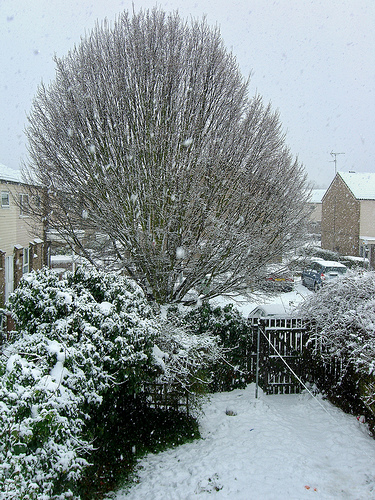It’s such a strange climate this winter. It’s been blustery, or worse, and it’s been wet, but we are still in late December experiencing temperatures in double figures across the country! Also I haven’t seen any frost, ice, snow, or hail, but don’t be lulled in to a false sense of security. Although we may not have a white Christmas, it’s difficult to predict when the first frosts might come – and to make sure your garden doesn’t fall foul of the bad weather, it’s imperative that you do what you can BEFORE the frosts arrive to protect your garden from the severe weather.
An unprotected garden can suffer from frost bite, or rotten roots, which will destroy your garden for the following year, undoing all of the hard work and plans you’ve put in to make your garden beautiful. You may have a tiny London back garden, or you may have an allotment, nonetheless, landscape gardener or not, you’ll need to be proactive to keep your garden well over the winter. Here are my top tips:
General preparation
Look around the garden. Any plants which only last for one season will have looked beautiful and done their job over the summer or early autumn, but by now, they will be on their way out and need removing. Add them to the compost pile, but don’t leave them in the soil over the winter.

If you have a pond, remember to put a net over it to prevent falling leaves landing in it and polluting the water. Also, if you have fish it’s imperative not to let the whole pond frost over. Throwing an inflatable floating ball onto the surface will ensure that when the pond ices over, there will be a hole where the ball has been – make sure to check for freezing over so that you can remove the ball to leave an air hole for the fish.
Outdoor Pots – relocation
For tender plants, it is important to relocate from outdoor to indoor over the winter. Plants don’t grow so well in the winter so they won’t need as much room, so you can re-pot them into slightly smaller pots, and not worry about giving them acres of room to grow either. They’ll be fine on windowsills or in a warm porch, within reason. A greenhouse is best but if you don’t have one a warm place indoors out of the way can be just as good.

Protective layer
On the soil, add a 2 inch or so layer of bark compost, or mulch, and just around the edge of your herbaceous perennials themselves (plants which will grow again after the first flower dies, as the roots underground stay alive) it is best to use grit. This will stop moisture collecting around them and prevent rotting, whilst the mulch will help to keep them warm. In time, the mulch will break down which will ease drainage (for instance after frosts thaw or in rainy seasons), whilst also adding nutrients to the soil.
Take clippings
Taking clippings can work both as an insurance policy, and to grow your stocks of plants. If a plant is outgrowing its surroundings, why not take clippings and then you can grow another plant which might not have so much going on. Also, should anything happen to the parent plant through the winter, at least you’ll have the clippings ready should you need to re plant and start again.

Take the clippings in the morning before the plants warm up. Clip only 2 to 4 inches, of non-flowering shoots. It’s important that the cuttings neither dry out nor get overly watered. Put them straight into a carrier bag, to minimise their perspiration. As soon as you can, take them over to prepare. Cut off the lower leaves, and using a knife or secateurs cut the cutting to approx. 3 inches in length. Make sure the remaining leaves aren’t too big as you don’t want them to touch – cut them back if need be. Put the cutting(s) into a pot of compost, poking a small hole for the cuttings to be placed in to, and packing the compost tight around the stem with no air holes. Keep in a controlled temperature (not outside for winter) – perhaps a windowsill indoors.
Falling Leaves
Try to rake away any fallen dead leaves as the combination of leaves and rain or snow can lead to slush and sludge, and although good for compost, needs to be managed and not overwhelm any areas of your garden unplanned.

Look after the trees and bushes
Young trees need a bit extra protection during the winter. Wrap stems or trunks with tree guards or wire to protect them from gnawing little friends. If you have short little bushes in pots, put up a screen around them to help protect them from the harsh winds.
If this is one of your first winters as a garden owner, don’t panic! The best thing about gardening is learning year on year how to make the most of your garden and work with the weather and all the other factors affecting the successful growth of your garden. One of the best things to do is to speak to more experienced gardeners and get local tips – it’s a great way to bond with neighbours, or something great to talk to parents and grandparents about.
As an owner of 2 businesses, Karen doesn’t get to enjoy as much time in her garden as she would like, but her relationship with All Seasons has taught her that planning is key, and that there are some things which can be worked on in the warmer months when you have more time, but there are also those key activities which are imperative to keeping your garden healthy all year round.

